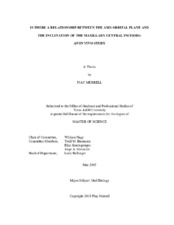| dc.contributor.advisor | Nagy, William W. | |
| dc.creator | Merrell, P Jay | |
| dc.date.accessioned | 2015-09-21T16:56:14Z | |
| dc.date.available | 2017-05-01T05:35:47Z | |
| dc.date.created | 2015-05 | |
| dc.date.issued | 2015-05-11 | |
| dc.date.submitted | May 2015 | |
| dc.identifier.uri | https://hdl.handle.net/1969.1/155056 | |
| dc.description.abstract | The purpose of this investigation was to evaluate if a relationship exists between the maxillary central incisors and the axis orbital plane determined by the SAM® anatomic face-bow. The study evaluated the angle formed by the incisal half (IA) and the cervical half (CA) of the tooth to the axis orbital plane and if there is a difference in angles with respect to gender. A relationship was determined to exist if the mean CA and IA angles where within 1 Standard Deviation (SD) of ±5° for each angle.
An anatomical face-bow (SAM Präzisionstechnik , Munchen) was used to locate arbitrary transverse mandibular axis on fifteen males and fifteen females. Photos of cast models were taken in the sagittal view of each subject mounted in the SAM III articulator. The JPEG images were imported into an imaging-editing program (Photoshop CS6, Adobe Inc, San Jose CA) where a line was drawn representing the axis orbitale plane. Two more lines were drawn representing the incisal and cervical half of the maxillary central incisors producing the incisal angle (IA) and the cervical angle (CA). A statistical analysis of the CA and IA angles was performed using statistical software (SPSS 19.0; SPSS Inc., Chicago IL). A non-parametric t-test (Mann-Whitney U) was used to indicate significant differences between the genders (p<0.05).
The mean cervical angles (CA) for males was 104.2°± 4.9 and for females 96.8°± 4.6. The mean incisal angles (IA) for males was 75.8°± 7.6 and for females was 68.2°± 6.6. There is a statistically significant difference (P≤0.001) between genders for both angles tested.
The results and data analyzed suggest a relationship between the mean cervical angle (CA) and the axis orbital plane for males (104.2) and females (96.8). There was no relationship shown between the mean incisal angle (IA) and the axis orbital plane for either gender. | en |
| dc.format.mimetype | application/pdf | |
| dc.language.iso | en | |
| dc.subject | Axis-Orbital Plane | en |
| dc.subject | Maxillary central inclination | en |
| dc.subject | | en |
| dc.title | Is There a Relationship between the Axis Orbital Plane and the Inclination of the Maxillary Central Incisors: An in vivo Study | en |
| dc.type | Thesis | en |
| thesis.degree.department | College of Dentistry | en |
| thesis.degree.discipline | Oral Biology | en |
| thesis.degree.grantor | Texas A & M University | en |
| thesis.degree.name | Master of Science | en |
| thesis.degree.level | Masters | en |
| dc.contributor.committeeMember | Baumann, Todd M | |
| dc.contributor.committeeMember | Kontogiorgos, Elias | |
| dc.contributor.committeeMember | Gonzalez, Jorge A. | |
| dc.type.material | text | en |
| dc.date.updated | 2015-09-21T16:56:14Z | |
| local.embargo.terms | 2017-05-01 | |
| local.etdauthor.orcid | 0000-0003-0204-9783 | |


